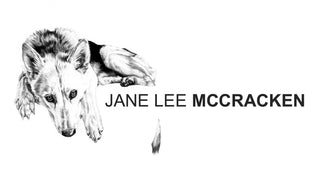Laguna

Laguna 2023 blue Biro drawing, Jane Lee McCracken
Laguna was created by Jane for Laguna Marine Wildlife project. The drawing evokes a sense of harmony between humanity and nature. Inspired by the Gabrielino-Tongva Nation, the indigenous tribe of coastal California, it melds elements of the flag’s design including a Tongva woman, a common bottlenose dolphin, and a California cone (sea snail) worn on the woman’s head. Both woman and dolphin are named ‘Laguna’ after the California city of Laguna Beach.
The drawing portrays a bountiful Pacific Ocean, teeming with California sea lions and other Californian species including garibaldi, the state fish. On the other hand, signs of discord between mankind and nature over the last 6,000 years is suggested throughout by depictions of threatened species including the critically endangered red abalone and the vulnerable California sheephead. A food source of California sheepheads and sea otters alike, purple sea urchins march across the drawing layers, their presence alluding to climate change—as sea temperatures rise the population of this kelp-eating species has swelled, threatening the survival of California’s beguiling kelp forests, integral as they are to local marine ecosystems, and reducing the sea-bed at many sites to a barren wasteland. The community of sea lions woven through the drawing was inspired by artist Rebeca Mendez’s poetic film The Sea Around Us, commissioned by Laguna Art Museum for the 2022 Art & Nature festival, in which references to environmental crises and the ancient culture of California’s indigenous people are intertwined.
The decline of Native Americans due to colonialization echoes throughout Laguna. Hollywood’s negative portrayal of indigenous peoples is highlighted through the woman Laguna’s body stance, which ironically mimics that of actress Raquel Welch in the theatrical release poster for the film One Million Years B.C. Welch and other prominent actors were critical of actress and activist Sacheen Littlefeather’s protest regarding Native American misrepresentation at the 45th Academy Awards. Laguna’s upper body was inspired by Wanada Parker, daughter of Comanche Chief Quanah Parker, artist Wendy Red Star, and model Quannah Chasinghorse. She wears items of traditional clothing including a tule grass skirt and an abalone shell necklace. The reference to One Million Years B.C. also serves as a reminder of the Paleolithic hunter-gatherers who peopled North America—not a million but 16,000 to 25,000 years ago.
The body of the dolphin Laguna acts as an evolutionary chronology of the Californian coast. At its beak, the sea-bed represents a time before homo sapiens existed; strands of kelp spiral towards the sunlight zone at its tail where the upwelling currents of colonization swirl around a submerged Main Beach Lifeguard Tower. Laguna Beach’s iconic landmark also symbolizes the city Jane cherishes, for family connections, the beauty of its natural surroundings, and the epic wildlife of the Pacific Ocean. A silhouette of Jane’s head appears on the tower wall. Sea lions cascade from the tip of the dolphin’s tail throughout the design, their presence an ode to the resilience of nature.
